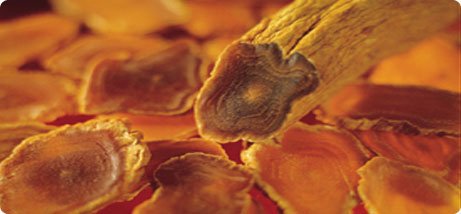Korean ginseng is rich in helpful plant saponins, specifically ginsenosides. Saponins have an adaptogenic quality in various species of life.
Most clearly, they are molecules used for the defense of an animal or plant's body. While concentrated naturally occurring forms of animal saponin can be dangerous (such as snake venom, which consists of animal-saponins), plant-based saponins are useful and healthy for human consumption (plant saponins include various phytochemicals and healthy ginsenosides).
These healthy plant components exist as the plant's immune system and some of these traits are passed along into humans, just as the healthy properties of anti-oxidants of fruits and vegetables may be. While ginseng is not classified as a drug, the research included in these papers suggested that Korean ginseng or components in Korean ginseng may help preventive the effects of several forms of harmful viruses. This supports the claim that Korean ginseng helps boost the immune system and illustrates why it has been historically used as a traditional medicine for 2,000 years.

Because saponins are often found in the skins of plants, such as red wine grapes (white wine is less healthy, because they do not contain the skins of the grape), KGC's Korean red ginseng is specially processed to preserve the skin. Additionally, the age of the skin is important. This makes KGC Korean red ginseng far superior to other ginsengs, as we specially process our ginseng to preserve the skin (resulting in a reddish color, superior to ordinary ginseng). Additionally, KGC's red ginseng is grown and cultivated for 6 years, ensuring the highest levels of saponin and ginsenoside, at the optimum year of harvest. This contrasts starkly to producers who harvest their ginseng after a mere two or three years with little concern for product quality.
Modern science has revealed that Korean ginseng contains a diverse variety of healthy plant components not found in any other plant. One of these components, called ginsenoside is the major active healthy component of Korean red ginseng. The scientific name for Korean ginseng is Panax Ginseng C.A. Meyer. The word 'Panax' is derived from a Greek phrase meaning 'to cure all' and this is almost entirely likely due to the superior health effects of ginsenoside saponins. Ginsenocide, saponins and other ginseng phytochemicals have adaptagenic properties in humans that help to activate the cellular functions of the body, while strengthening immunity. One has to be careful to distinguish Korean red ginseng from mass produced Chinese, Japanese, American, and other ginsengs, which are notably less effective, grown for far fewer years, are often not properly handled, usually skinned, and which cannot compare to the specially aged six-year-old root of KGC's Korean red ginseng with over 100 years of organizational tradition in tending to this one particular highest-value quality product.
Comparison of main active ingredients among Korean Ginseng (P. panax), and American ginseng (P. quinquefolius).
| Active Ingredient | Korean Red Ginseng | American Ginseng |
|---|---|---|
| Saponin (kinds) | 31 | 19 |
| PD/PT Ratio | 1.33 | 2.15 |
| Polyacetylene (%) | 0.089 | 0.064 |
| Acidic Polysaccharide (%) | 7.74 | 2.09 |
| Classification | Active Ingredient | Benefits |
|---|---|---|
| Saponin | Ro | Alcohol detoxification, immune system, anti-inflammation |
| - PD | Rb1 | Central nerve control, liver protection, anti-oxidant |
| - PT | Rc | Sedative, protein and lipid synthesis facilitation |
| Re | Blood regulation, anti-oxidant | |
| Rf | Neuron protection | |
| Rg1 | Supporting cognition, anti-fatigue, anti-stress, immune system, inhibiting platelet aggregation. | |
| Rg3 | Supporting memory functions, immune system, liver protection. | |
| Rh1 | Liver protection, immune system. | |
| Rh2 | Immune system. | |
| Non-saponin | Polyacetylene | Immune system, preventing thrombosis, inhibiting lipid peroxidation. |
| Phenolic Compounds | Antioxidant, anti-aging. | |
| Acidic Polysaccharide | Anti-aging, reducing the side effects of certain anti-cancer drugs, immune system, preventing hyperlipidemia. | |
| Insulin Analogue | Lowering blood-sugar levels. |




